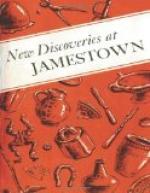The largest and most representative collection of 17th-century European and early American pottery which has been excavated in America is on exhibition at Jamestown. Thousands of fragments of colorful types have been found, and by the exercise of extreme care and patience, museum technicians have pieced together many early specimens. These examples reveal the kinds of pottery used in the wilderness settlement over three centuries ago. Included in this ceramic collection are pitchers, bowls, jugs, cups, mugs, porringers, milk pans, jars, plates and dishes, pots, and platters. These were used at the table, as well as for the storage of foods, and for other purposes.
While some of the utilitarian earthenware was made at Jamestown, most of the pottery that has been found was imported from England. Many types also came from other European countries, including Germany, Holland, Italy, Spain, and Portugal. One kind of maiolica may have been made in Mexico, while the few fragments of porcelain recovered were made in China.
Because of the great variety and importance of the ceramic collection, a few of the more representative types will be described briefly.
[Illustration: A few knives, forks, and spoons unearthed at Jamestown.]
[Illustration: The pewter spoon handle at the top, unearthed at Jamestown, is the oldest dated piece of American pewter in existence. It was made by Joseph Copeland of Chuckatuck, Va., In 1675. The spoon on the bottom is A conjectural restoration of COPELAND’S specimen.]
[Illustration: A few examples of lead-glazed earthenware made in England during the 17th century. All were unearthed at Jamestown.]
[Illustration: Examples of lead-glazed earthenware made at Jamestown about 1640-50.]
[Illustration: English sgraffito, or scratched, ware—one of the most colorful types of pottery unearthed at Jamestown.]
[Illustration: English slip-decorated ware. Although made in England mainly for local consumption, many attractive examples were shipped to Virginia during the 17th century.]




